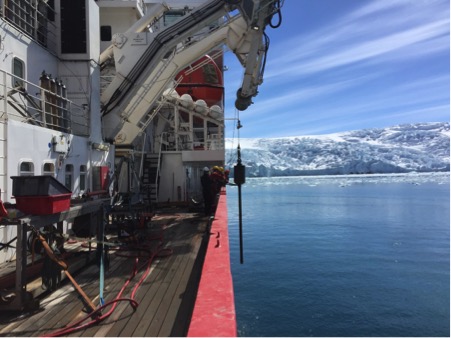Glacial to Holocene Antarctic change
Antarctica is one the fastest changing regions of the world in terms of global warming, with significant ice sheet loss on the West Antarctic Peninsula in recent decades and changing ocean circulation. We are studying marine sediment cores from offshore Antarctica, the Falkland Plateau and South Georgia, analysing chemical proxies for changes to ocean temperature and biota.

Deployment of gravity corer from the RRS James Clark Ross, proximal to a recently retreated ice shelf within Marian Cove, King George Island. Image credit: Sev Kender
Dr Sev Kender travelled to the Antarctic Peninsula in December 2018 on the British Antarctic Survey research ship RRS James Clark Ross, where he collected sediment cores from underneath recently melted ice shelves. His project was funded by a grant from the Collaborative Antarctic Science Scheme. The main aims are to ascertain the primary cause of warming, and the response of ocean biota including diatoms and foraminifera. Recent research carried out by our group has indicated that upwelling of warm Upper Circumpolar Deep Water has increased in recent decades, similar to the early Holocene, which may account for this melting. You can read about some of this research in an article for The Conversation.
Our team is also involved in a large European Research Council Synergy grant that is employing novel techniques to understand the changes in ocean biota throughout the Holocene. The ‘Seachange’ project, worth 11.75 million euros, brings together scientists from four institutions across Europe including the University of Exeter. Part of the project Dr Sev Kender and Prof James Scourse are involved with combines ancient environmental DNA trapped within the ocean sediment, and conventional microfossil palaeontology, to gain a better understanding of the changes to Antarctic marine life through time.
Key Publications
Dejardin R, Kender S, Allen CS, Leng MJ, Swann GEA, Peck VL. (2018) "Live" (stained) benthic foraminiferal living depths, stable isotopes, and taxonomy offshore South Georgia, Southern Ocean: Implications for calcification depths, Journal of Micropalaeontology, volume 37, no. 1, pages 25-71, DOI:10.5194/jm-37-25-2018.
Roberts J, McCave IN, McClymont EL, Kender S, Hillenbrand CD, Matano R, Hodell DA, Peck VL. (2017) Deglacial changes in flow and frontal structure through the Drake Passage, Earth and Planetary Science Letters, volume 474, pages 397-408, DOI:10.1016/j.epsl.2017.07.004.
Hillenbrand CD, Smith JA, Hodell DA, Greaves M, Poole CR, Kender S, Williams M, Andersen TJ, Jernas PE, Elderfield H. (2017) West Antarctic Ice Sheet retreat driven by Holocene warm water incursions, Nature, volume 547, no. 7661, pages 43-48, DOI:10.1038/nature22995.
Roberts J, Gottschalk J, Skinner LC, Peck VL, Kender S, Elderfield H, Waelbroeck C, Riveiros NV, Hodell DA. (2016) Evolution of South Atlantic density and chemical stratification across the last deglaciation, Proceedings of the National Academy of Sciences of the United States of America, volume 113, no. 3, pages 514-519, DOI:10.1073/pnas.1511252113.
Peck VL, Allen CS, Kender S, McClymont EL, Hodgson D. (2015) Oceanographic variability on the West Antarctic Peninsula during the Holocene and the influence of upper circumpolar deep water, Quaternary Science Reviews, volume 119, pages 54-65, DOI:10.1016/j.quascirev.2015.04.002.
